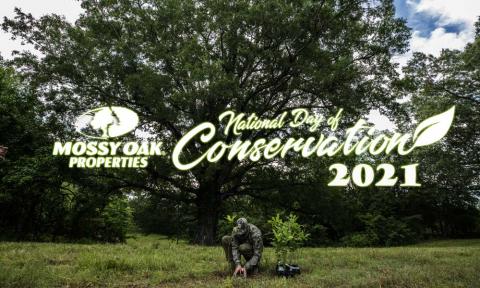provided by John E. Phillips
Many GameKeepers and biologists name feral hogs as the worst critters in the woods for destroying ground-nesting birds’ nests, like grouse, bobwhite quail and turkeys. They eat their eggs, out-compete deer for natural food, destroy crops, root-up green fields and roads, eat supplemental feed intended for deer and turkeys, kill newborn fawns, threaten wetlands habitat and destroy ecosystems. Their reproductive rate is unbelievable with wildlife researchers saying that one sow can have two litters of four to six piglets per year.
Dr. Stephen Ditchkoff, a professor of Wildlife Ecology at Auburn University, is a member of one of two research teams nationwide studying feral hogs and the impact these nuisance animals have on wildlife, farming and water systems and the problems they cause.
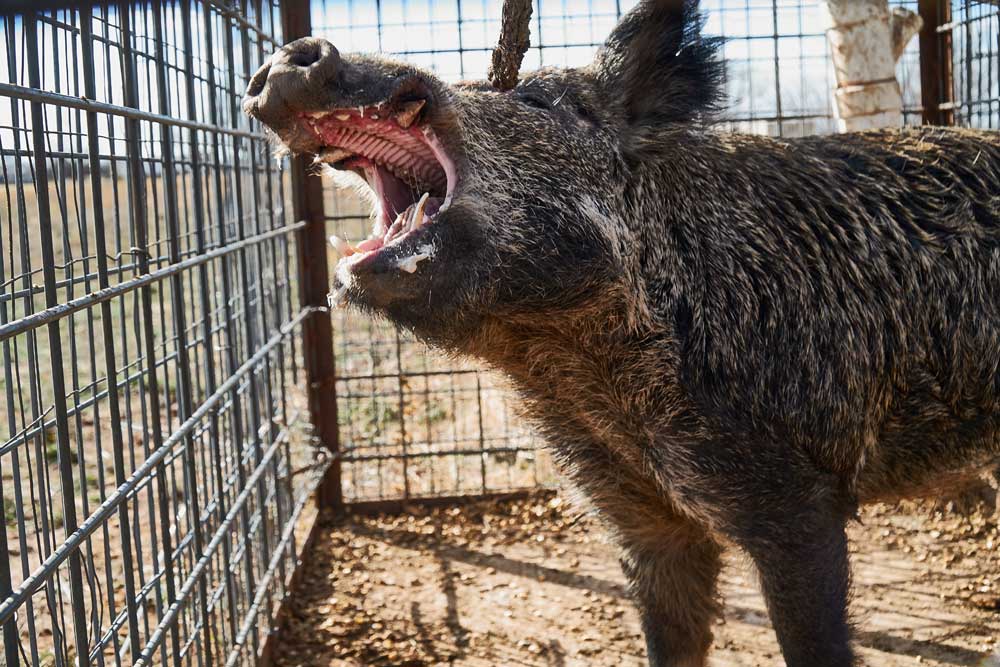
“I’m one of a number of wildlife researchers who are studying the effects of wild hogs on our environment,” said Ditchkoff. “A small group of researchers actually have conducted quite a bit of research on feral pigs for the last 10 years. This group decided there was a need for a comprehensive book that summarized and compiled the known information of wild pigs in North America. The book is, ‘Invasive Wild Pigs in North America: Ecology, Impact, and Management,’ and it’s available on Amazon.”
Ditchkoff received the Wildlife Society’s Publication Award for this book he researched, wrote and edited with five other researchers. The book cites wild pigs as, “The most destructive, introduced vertebrate species in the U.S.”
How bad is the feral-hog problem nationwide?
Feral hogs are a considerable problem, but at this time, I don’t think it’s getting much worse. At one time, 47 of our 50 states had problems with feral hogs. I think currently, there’s only about 35 states having problems with wild hogs. For instance, in Montana, that state had feral pigs at one time, but the state got rid of those feral swine as soon as they noticed them. In recent years, there’s been such a big concern nationally that the federal government has appropriated money to tackle the problems associated with feral hogs.
We’ve seen some success stories in states like Pennsylvania and New York in eliminating wild pigs, and today there’s an increased awareness among the general public about the damage that wild pigs cause to the environment. States in the Deep South like Alabama, Mississippi, Louisiana and Florida have made a concerted effort to not allow the spread of wild hogs into new areas. Currently, we believe that the growth of feral hogs nationwide is at a standstill. Finally, there’s optimism that we can make even more progress to stop the growth of wild hogs nationwide. We think in the next 5 years we will have a toxicant that we’ll be able to better tackle this problem with, and that will allow us to eliminate large numbers of wild pigs where they’re found.
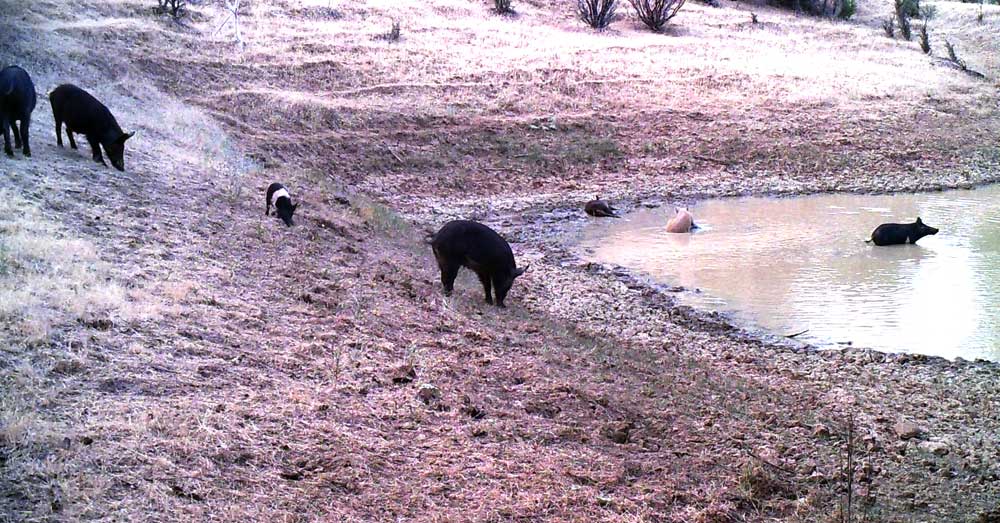
What is a toxicant, and what toxicant seems to be offering a possible solution to eliminating feral hogs?
Right now, the U.S. Fish and Wildlife Services are going through the testing phases of using sodium nitrite to rid landscapes of feral swine. Sodium nitrite has been tabbed for a number of years as being a very humane but effective toxicant for wild pigs. Also, the U.S. Fish and Wildlife Service wants to know what the potential is of non-targeted species being affected by this chemical. Currently, they are formulating this chemical – sodium nitrite in a bait and using feeders and protocol to test it to see just how effective it’ll be when eaten by wild pigs. They’re waiting for the EPA (Environmental Protection Agency) to say whether this product can be used in a certain way to manage and reduce populations of feral pigs. This process of going through all the EPA regulations may take from 3-5 years to be completed.
Where does the problem with wild pigs seem to be the worst in the United States?
Texas appears to have the worst problem of any state. Pigs are also creating many problems in Hawaii, and certain parts of California also have feral pigs that are causing a really big problem. But any state from South Carolina to Texas that lies in that Deep South region will have individual areas where the pig problem is really bad, and other places where it’s not as bad. However, from the reports we’re getting, Texas seems to be having as bad a problem or worse problems of any state in the nation.
Understand Trapping Wild Pigs and the Extent of Their Damage
Trapping is our best tool to eliminate hogs right now. Shooting hogs out of helicopters has proven to be an effective tool as well in some areas with very open land, like in Texas and some sections of Alabama. But right now, trapping is still our best tool for eliminating wild hogs, when it’s used effectively.
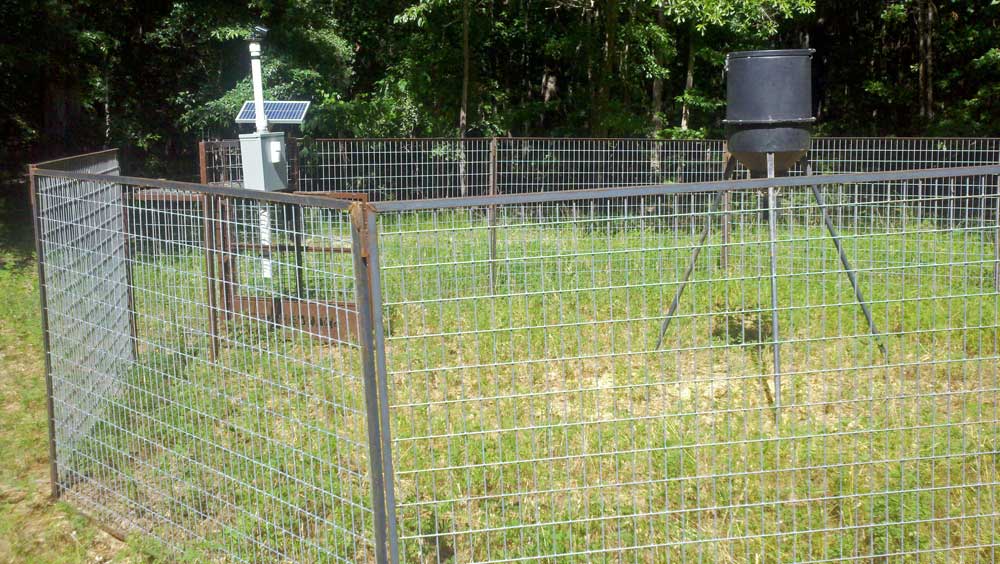
Wild pigs move in what’s known as a sounder, which is a group of related female hogs and their offspring. So, once you’ve identified the sounder, you target that specific group of hogs to trap. The idea is, if you catch all the pigs in the sounder at one time, and you don’t leave any pigs behind that are educated as to what a trap is or leave any wild pigs to reproduce, you can eliminate a group of hogs from one area. There are several steps to trapping feral hogs effectively:
1) Use bait and trail cameras to get a group of hogs to come in and feed on that bait.
2) Try to identify each pig in that group of hogs once you have trail-camera pictures of all the hogs in the sounder to know that the sounder is comprised of perhaps 8 individuals, 10 individuals or possibly 12 individuals. You need to be able to determine if there’s 6 or 8 adult individuals, or perhaps 4 to 5 juvenile pigs in that sounder.
3) Build a trap that will hold the entire sounder, start baiting the trap, and watch the hogs coming into the trap. You continue that baiting with the door to the trap up and open, so the pigs can get to the bait. Don’t try to catch the hogs, until you’re absolutely sure you have all the individual hogs from the sounder in that trap.
4) Use a device that will drop the door to the trap with all the hogs in the sounder.
5) Go to your trap, dispatch all the wild pigs, take them out of the trap, and dispose of them.
6) Continue to bait the trap to make sure that you’ve eliminated every hog in that sounder.
(Note: There are new types of traps and doors that can send pictures to your cell phone, computer, tablet or other device, so that you can see how-many hogs are in a sounder and identify the hogs in the trap. Once you’re convinced you’ve got the entire sounder, you can activate the app on your phone, which automatically will drop the door on the trap preventing the pigs from getting out.)
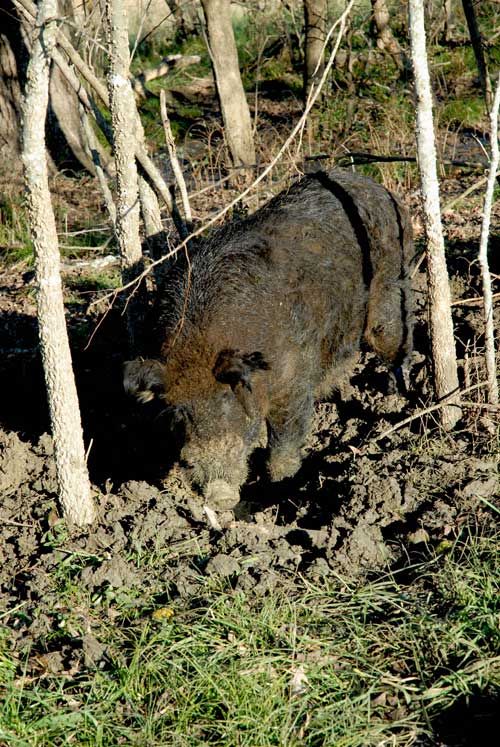
The NRCS (Natural Resource Conservation Services) offer some programs that allow landowners and/or hunting clubs to purchase traps to remove feral pigs. The program has varied over the years, and I don’t feel qualified to give you the details of the program. But I know the National Resources Conservation Service (NRCS) does have a program going on in four counties where the group is targeting some various watersheds. I believe some of the cost of the traps may be subsidized by these programs.
How involved has the federal government been with the feral-hog problem?
About 7 or 8 years ago, the federal government decided it needed to do something and started sending $25 million a year to Wildlife Services (Wildlife Services is within the U.S. Department of Agriculture). Wildlife Services is the wildlife-problem organization that helps research and develop solutions to nuisance-animal problems. The purpose of the $25 million was to control wild pigs, do research on wild pigs, learn how to better improve effectiveness of reducing this problem and also possibly do some disease testing. In more recent years, the appropriation has jumped from $25 to $35 million as the USDA has begun to see and realize the damage that wild pigs have been doing to crops, water systems and farm equipment – especially from the landowner’s perspective. Some of that money has been used to eliminate wild pigs from northern lands, where they could be eliminated effectively. Other monies from this program have been used to better understand what impact feral swine are having on wildlife, and how we can control feral swine better.
This rough estimate - which we scientists believe is way underestimated - is that wild pigs do $1.5 billion in crop damage annually in the U.S. We believe the actual number of dollars of feral swine crop damage is much larger than that. I know that in Alabama some biologists and wildlife researchers estimate around $50 million a year in crop damage by wild pigs in that one state. Remember that Alabama is known more for raising cotton than for growing corn, soybeans and row crops – which is what wild hogs prefer. The biggest problem with hogs in Alabama is they’re destroying peanut and corn crops.

How much damage is being done by feral pigs in the U.S. Heartland along the Mississippi River from north to south?
The Mississippi Delta is covered up with pigs. Something we’ve found that helps in these major agricultural areas is that most of those farming practices are large-field farming with few woodlots and thickets where the hogs can live and breed. In the farming country of southern Ohio and Michigan, the soil is so rich that just about every acre that can be tilled for crops is tilled for crops. So, because there’s not much breeding habitat or cover for wild pigs, that limits the number of feral swine an area can support. But as you come further south on the Mississippi River with its seasonal floods, swampy and thick areas like in Arkansas, Louisiana and Mississippi that are close to the river, you’ll find plenty of wild pigs. Throughout many of the Hawaiian Islands, wild pigs have created extensive problems too with water systems and soil- erosion problems.
When feral swine move into a green field, they not only root up the crop planted in that field but discourage other wildlife from using those fields. But an even bigger problem is that they can cause destruction to tractors and tractor equipment. For instance, in Oklahoma where farmers raise a lot of hay, farmers can’t see places where the hogs have rooted up ditches in hay fields. I’ve heard stories of tractor axles being broken when a tractor is driven through a field and hits one of those ditches that hogs have rooted up that can’t be seen. At Fort Benning in Columbus, Georgia, wild pigs have rooted up the open fields where paratroopers have to land, causing broken bones when they land in some of the holes the hogs have created. There are many different ways that wild pigs create problems not only for hunters and farmers, but for people in general.
The History of Wild Pigs
Up until about 30-40 years ago, wild pigs weren’t a problem in most states. They were primarily in the southern sections of the Deep South states where there was more water, more cover and better habitat for them to live. So what caused the rapid growth of feral hogs nationwide?
Feral hogs were introduced to the United States in the early 1500s by European explorers, and contrary to what most people believe, wild pigs didn’t naturally move across the United States at a rapid rate. They moved across the landscape relatively slowly. When you consider they’ve been in the landscape of the U.S. for about 500 years, and we don’t have them in every section of each state, that tells you that the hogs - left to their own devices - move across the landscape fairly slowly. If you Google, “Home range of feral hogs in the 1980s,” you’ll see that there were relatively small populations of feral pigs in the Southeast, Hawaii and in small regions of California, but in the 80s and 90s, there was an explosion of feral hog populations nationwide.
Around that time, the cable TV industry exploded, and many of them had 24-hour programming. More outdoor shows began to feature programming on feral-pig hunting. Numbers of deer hunters from all over the nation started saying, “I sure would like to have wild hogs on the property I have that we could take during the spring and summer months when it’s not deer season.” And that’s when more and more people started trapping and transporting feral hogs throughout the nation, never realizing what a major nuisance these non-native species would be to agriculture and wildlife where the hogs were released.
The 1980s and 1990s saw a massive explosion of wild pigs in regions where they’d never been seen previously. This massive explosion of wild swine primarily was created by the desire of hunters to have pig hunting on the lands they hunted. As more people became aware of the sport of feral-hog hunting, and as cable TV offered more shows about the sport of harvesting feral swine, more hunters wanted wild pigs to hunt on their lands. However, in the last 20 years, many states have passed laws making transporting feral hogs from state to state and within states illegal.
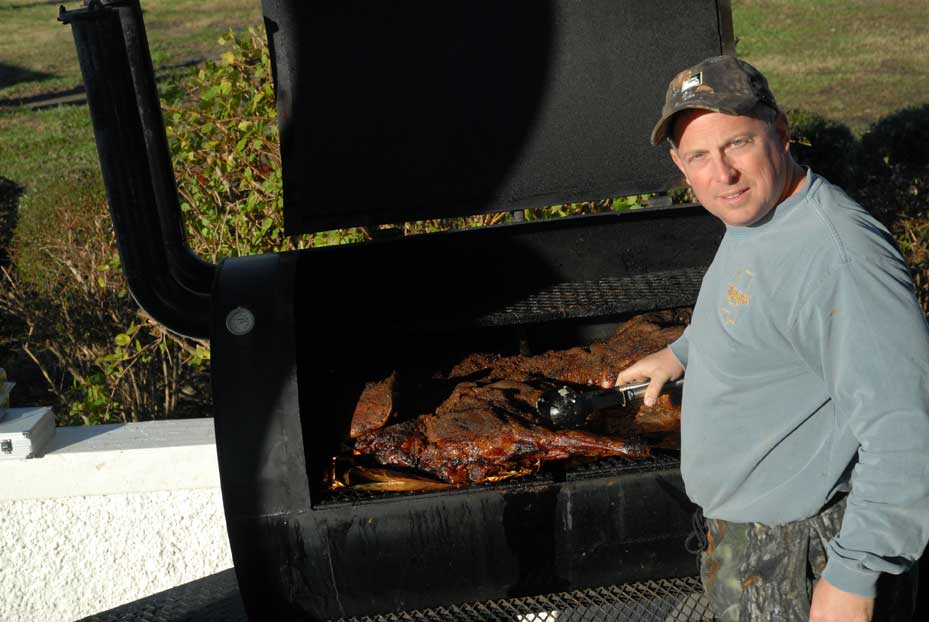
Can You Eat Wild Pigs?
Yes, feral hogs are good to eat, and yes, they do carry diseases. The number-one disease that they carry is trichinosis, and wild pigs also carry brucellosis. Wildlife researchers and biologists encourage anyone who’s handling wild pigs to wear gloves, because brucellosis can cause major problems with humans. When you’re cooking wild pigs, make sure that the meat is thoroughly cooked (in other words, don’t opt for rare or medium-rare wild pork).
This idea of letting people trap feral hogs and sell the meat sounds wonderful initially. In the short term, this practice can help to reduce the number of wild pigs on the landscape. However, in the long term, this practice creates an incentive to maintain and grow feral-hog populations, because the people in the states where selling feral hogs is legal are trying to maximize their profits by having more and more hogs to catch and sell. But landowners who grow agriculture and sell hunting rights want to reduce feral-pig populations to protect their crops and produce more and better wildlife.
The Future of Wild Hogs
Ten years ago, we weren’t very optimistic about our ability to solve the wild-pig problem, but as we learned more and better information, and had better tools and toxicants that would help solve the wild-pig problem, we’ve started hoping to reduce numbers of feral hogs on the landscape. With toxicants being able to eliminate wild pigs where there’s not high numbers already, our chances of completely eradicating wild hogs in some areas and greatly reducing wild hogs in other places has caused us to be very optimistic that we may have better control methods in the next 5 years and possibly may eliminate feral hogs in the next 20 years.
Having said that, I also need to say that I don’t believe we’ll be able to completely eliminate wild hogs in my lifetime. And here’s why: wild pigs are a private-landowner problem with some landowners wanting to keep wild hogs on their lands, you may not be able to eliminate the pigs. However, if there was a wildlife management area (WMA) of 20,000 acres or a 50,000-acre national forest that was publicly owned, and that state or federal agency wanted to get rid of the hogs on those areas, I believe we’ll have the tools to reach those goals within the next 5 years. Of course, we’ll never be able to force private landowners to eliminate wild pigs on their lands, if they don’t want to have those pigs eliminated.
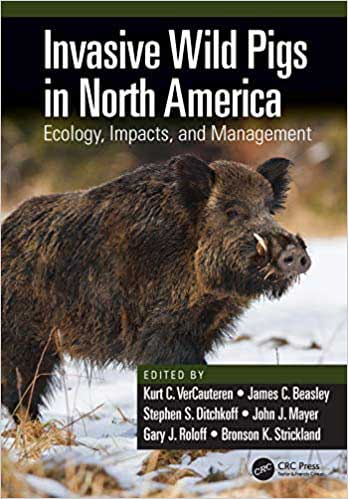 I do believe we’ll be able to eliminate feral hogs on piece-by-piece properties where the landowner wants the hogs removed within the next 20 years. I believe that in future years, farmers having problems with wild hogs destroying their crops will be able to have effective tools to stop that crop damage. When neighbors start cooperating with neighbors, and all those property owners agree to eliminate wild pigs, we’ll have the tools to solve their problems. I believe 50 years from now; we’ll have a far different U.S. landscape with fewer wild pigs on that landscape. And I believe that within 5 years from now, a farmer that has 5,000 acres of crops that get destroyed every year by wild pigs will be able to use toxicant around his crops, save his crops and rid his land of pigs.
I do believe we’ll be able to eliminate feral hogs on piece-by-piece properties where the landowner wants the hogs removed within the next 20 years. I believe that in future years, farmers having problems with wild hogs destroying their crops will be able to have effective tools to stop that crop damage. When neighbors start cooperating with neighbors, and all those property owners agree to eliminate wild pigs, we’ll have the tools to solve their problems. I believe 50 years from now; we’ll have a far different U.S. landscape with fewer wild pigs on that landscape. And I believe that within 5 years from now, a farmer that has 5,000 acres of crops that get destroyed every year by wild pigs will be able to use toxicant around his crops, save his crops and rid his land of pigs.
My understanding of this new chemical toxicant (sodium nitrite) that’s being developed is that it’s 90% effective within one night. The testing is happening right now to collect data to send to the Environmental Protection Agency (EPA). The good news is, I believe that once this toxicant has been tried, tested and approved by the EPA, it won’t be very expensive. Since it’s being formulated by the federal government, the federal government isn’t in this research to make money. It’s trying to solve the problem. I believe the cost will come in to the equation with the application of the toxicant, since it probably will have to be applied by someone who’s licensed to use this toxicant to eliminate feral hogs. The cost also will be determined by the number of people who are licensed to apply it. In the short term, I don’t believe the landowner himself will be able to get the toxicant. My guess is you’ll have to have this toxicant applied by someone who’s gone through training about how, where and when to apply it and is licensed to do that. I don’t know how the product will be licensed if and when it’s approved. My guess is there will be a group of private contractors that will be trained and contracted with the use of the product, depending on the demand from farmers and landowners.
To get more information about how to control feral hogs, go to any state’s cooperative extension agency pages. Many states have cooperative extension agencies in various counties. For more technical information, I suggest you check out and purchase the book that has all the latest research on controlling, managing and eliminating feral pigs.














